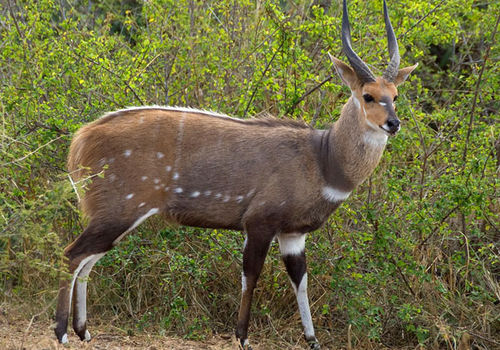
Bushbuck
Tragelaphus scriptusBushbuck
Introduction: The bushbuck (Tragelaphus scriptus) is so called because it indicates the type of habitat with which it is associated. They are normally found in riverine or other types of underbush near to permanent water supplies. Cover and availability of water are the most important habitat requirements for the bushbuck. They are generally regarded as solitary animals, but can occur in small groups of perhaps 2 or 3. It is widely recorded that they lie up in dense bush during the day, moving and feeding at night.
Bushbuck can also take to water and are fast, manoeuvrable swimmers and are difficult to catch in the water. They have been known to swim up to 3km without tiring and freely enter the water to feed. This is an asset when being sought by the larger carnivores such as leopard, lion, spotted hyena, the African wild dog and pythons.
Distribution: Bushbuck are very rare in Namibia and can only be found in the Caprivi region, due to their very specialized habitat requirements.
Diet: Browsing and to a lesser extent grazing consisting of leaves, fine twigs with buds attached, and the flowers and fruits of a wide variety of plants, including sausage tree, white berry bush and thorn trees.
Colouring: Adult males are dark brown and they have a crest of longer white or yellowish-white hair extending from the top of the shoulders to the base of the tail. The top of the tail is the same colour as the body, but a pure white underneath. Adult females are lighter in colour than adult males.
Breeding: Young are born throughout the year and gestation period is around 180 days. A single young is born, with the mother hiding the young in dense undergrowth, returning only to suckle it periodically until it is strong enough to move freely by itself.
Size: They are a medium-sized antelope with adult males standing around 80cm at the shoulder, weighing around 40kg. Females are smaller, standing at some 70cm at the shoulder with a mass of some 30kg.
Klein Windhoek

